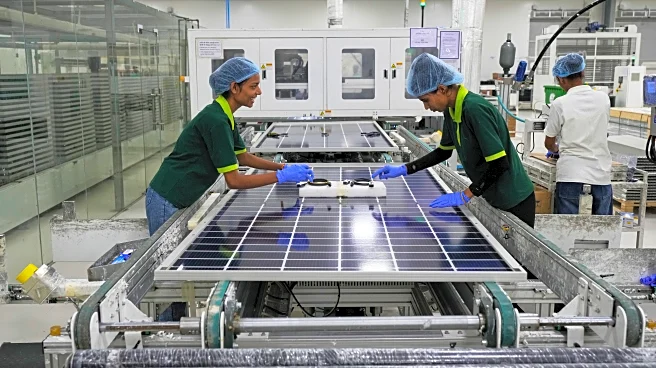What's Happening?
VDE Americas and the Renewable Energy Test Center (RETC) have introduced the Hail Resiliency Curve (HRC) Test, a new protocol designed to assess the resilience of solar panels against hail damage. This test marks a significant advancement over existing industry standards by simulating real-world hailstorm conditions, where solar panels are subjected to impacts from various hailstone sizes and wind speeds. The HRC Test aims to provide solar panel manufacturers, project developers, and insurance providers with empirical data to optimize product designs, perform cost-benefit analyses, and appropriately size hail damage coverage. The test involves firing hailstones at solar panels until glass fracture occurs, offering a detailed understanding of a panel's breaking point. Early adopters of this test include a diverse range of solar manufacturing companies, from publicly traded entities to startups.
Why It's Important?
The introduction of the HRC Test is crucial for the solar industry as it addresses the need for more rigorous hail testing protocols. By providing actionable data on solar panel resilience, the test helps manufacturers improve product designs and offers project developers and insurers a reliable basis for decision-making. This development is particularly significant in regions prone to severe hailstorms, where solar installations face substantial risk. The test's ability to reduce uncertainty in hail damage predictions can lead to more accurate insurance premiums and investment decisions, ultimately fostering greater confidence in solar energy projects. As the solar industry continues to grow, innovations like the HRC Test are essential for ensuring the durability and reliability of solar technologies.
What's Next?
The HRC Test is expected to become a standard tool for solar panel manufacturers and project developers seeking to enhance the resilience of their products. As more companies adopt this testing protocol, it could lead to widespread improvements in solar panel designs, reducing the risk of hail damage and potentially lowering insurance costs. Additionally, the data generated from these tests may influence future industry standards and regulations, promoting the development of more robust solar technologies. Stakeholders in the solar industry, including investors and insurers, are likely to closely monitor the outcomes of the HRC Test to inform their strategies and policies.
Beyond the Headlines
The HRC Test not only impacts the solar industry but also highlights broader trends in renewable energy resilience and risk management. As climate change increases the frequency and severity of extreme weather events, the need for resilient infrastructure becomes more pressing. The test underscores the importance of integrating scientific research and empirical data into the design and evaluation of renewable energy systems. This approach could serve as a model for other sectors facing similar challenges, promoting a culture of innovation and adaptability in the face of environmental uncertainties.












